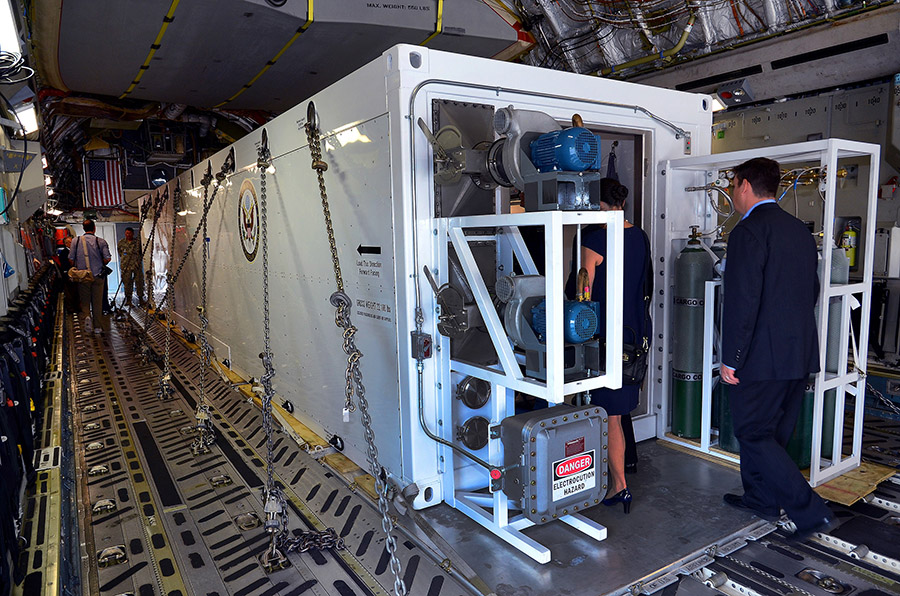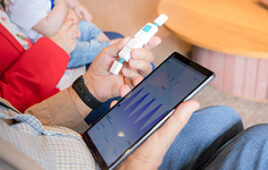
Invited guests and the press tour the second Containerized Biocontainment Systems unit positioned on a U.S. Air Force C-17 at Dobbins Air Reserve Base, Ga. in 2015. (U.S. Air Force photo / Brad Fallin.)
In 2016, the Containerized Bio-Containment System (CBCS), developed by Kansas City-based MRIGlobal — with support from HHI Corp., GPA Services L.L.C., the U.S. State Department, and The Paul G. Allen Ebola Program — was named one of the R&D 100 winners. The system is a first-of-its-kind, flyable medical transport unit and features full biocontainment. It is designed for high containment of all types of highly pathogenic organisms, such as Ebola. The biocontainment aspects of the advanced design result from years of refinement and research.
The units feature three rooms: a patient treatment area for four patients and four caregivers; an ante room to safely put on and take off personal protective equipment; and a rest area for two caregivers. Pilots can cargo the CBCS in private or military aircraft, with confidence that the biocontainment is safe and effective. The CBCS units can also be safely moved by truck.
The CBCS is designed to survive crash loads and rapid decompression per DOD Safe-to-Fly standards, and the entire system can be rapidly de-contaminated and put back into service immediately. Extensive domestic and international training exercises have proven that the CBCS can handle the ever-evolving global threat of a disease outbreak.

The second Containerized Biocontainment Systems unit was loaded into a U.S. Air Force C-17 to provide an example of how the unit could be airlifted to anywhere in the world if needed, Dobbins Air Reserve Base, Ga., Aug. 11, 2015. The two Containerized Biocontainment units built by MRIGlobal through a partnership with the U.S. State Dept. and the Paul G. Allen Ebola Program, will be positioned at Dobbins ARB, ready for future. (U.S. Air Force photo/ Brad Fallin)
This past week, the CBCS was brought into the ongoing worldwide coronavirus outbreak. According to a State Department release, more than 300 U.S. citizens and their immediate family members — passengers on the Diamond Princess cruise ship have been evacuated. (The cruise ship had been quarantined off the Japanese coast for 10 days.) After disembarking, they were taken to buses and transported to Haneda airport, where they boarded a plane bound for California. For the 14 passengers who had earlier tested positive for COVID-19, they went into the CBCS units, which were also on the plane. There, they were able to make the flight home while remaining isolated from the remaining passengers.
MRIGlobal designed and fabricated the two units for the U.S. Department of State in 2015 with funding from the Paul G. Allen Foundation. The impetus for the CBCS was the Ebola crisis. Since their completion in 2015, the units have resided with their owner, the U.S. Department of State.
To date, MRIGlobal has designed and delivered four CBCS units, all of which are in use by the U.S. government. While MRIGlobal designed and fabricated the units, it has not been involved in their use or operation.
The CBCS units were also used in the Tranquil Shift, an international exercise held in Senegal in 2015: https://africatimes.com/2017/04/19/tranquil-shift-drill-in-senegal-sierra-leone-tests-new-outbreak-evacuation-system/
“We’re proud to play a part in helping to safely evacuate people out of harm’s way to locations where they can receive appropriate medical care,” said Dean Gray, Ph.D., Director at MRIGlobal. “There’s nothing like the CBCS for flyable medical transport. It was developed to respond to critical global health situations like the coronavirus outbreak, and ultimately to save lives.”
MRIGlobal
https://mriglobal.org





Tell Us What You Think!